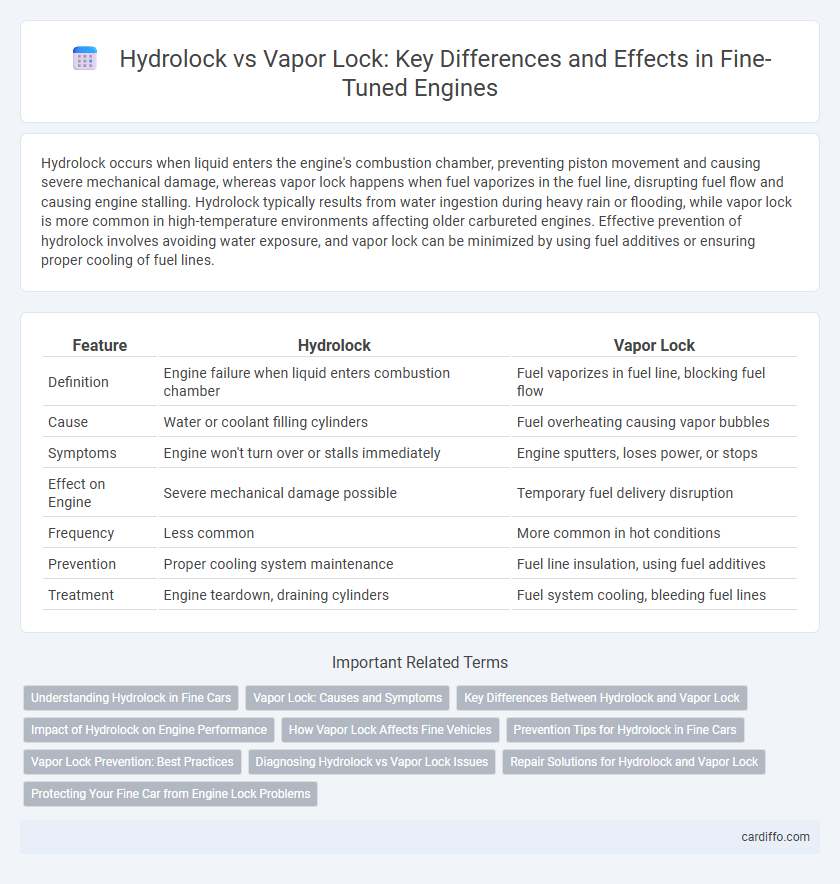Hydrolock occurs when liquid enters the engine's combustion chamber, preventing piston movement and causing severe mechanical damage, whereas vapor lock happens when fuel vaporizes in the fuel line, disrupting fuel flow and causing engine stalling. Hydrolock typically results from water ingestion during heavy rain or flooding, while vapor lock is more common in high-temperature environments affecting older carbureted engines. Effective prevention of hydrolock involves avoiding water exposure, and vapor lock can be minimized by using fuel additives or ensuring proper cooling of fuel lines.
Table of Comparison
| Feature | Hydrolock | Vapor Lock |
|---|---|---|
| Definition | Engine failure when liquid enters combustion chamber | Fuel vaporizes in fuel line, blocking fuel flow |
| Cause | Water or coolant filling cylinders | Fuel overheating causing vapor bubbles |
| Symptoms | Engine won't turn over or stalls immediately | Engine sputters, loses power, or stops |
| Effect on Engine | Severe mechanical damage possible | Temporary fuel delivery disruption |
| Frequency | Less common | More common in hot conditions |
| Prevention | Proper cooling system maintenance | Fuel line insulation, using fuel additives |
| Treatment | Engine teardown, draining cylinders | Fuel system cooling, bleeding fuel lines |
Understanding Hydrolock in Fine Cars
Hydrolock in fine cars occurs when liquid enters the engine cylinders, preventing piston movement and causing severe mechanical damage. Unlike vapor lock, which is a fuel delivery issue caused by fuel vaporizing in the fuel lines, hydrolock results from coolant or water intrusion, often due to cracked engine blocks or failed head gaskets. Early detection through compression tests and leak-down tests is crucial to prevent costly repairs and maintain optimal engine performance in luxury vehicles.
Vapor Lock: Causes and Symptoms
Vapor lock occurs when fuel vaporizes in the fuel line or carburetor, disrupting the continuous flow of liquid fuel to the engine. Common causes include high ambient temperatures, inadequate fuel pressure, and prolonged idling or heavy engine loads that increase fuel temperature. Symptoms of vapor lock include engine stalling, hesitation during acceleration, difficulty starting the engine, and a noticeable drop in engine power.
Key Differences Between Hydrolock and Vapor Lock
Hydrolock occurs when liquid water enters the engine cylinders, preventing the pistons from moving and causing severe mechanical damage, while vapor lock happens when fuel vaporizes in the fuel delivery system, disrupting fuel flow and causing engine stalling. Hydrolock results in immediate engine failure requiring extensive repairs, whereas vapor lock typically causes temporary engine performance issues that can be resolved by cooling the fuel system. The primary distinction lies in hydrolock involving liquid intrusion and mechanical blockage, whereas vapor lock involves fuel vaporization and fuel delivery interruption.
Impact of Hydrolock on Engine Performance
Hydrolock occurs when a significant amount of liquid enters the engine cylinders, preventing the pistons from completing their cycles and causing severe mechanical damage. This condition leads to immediate engine stall, bent connecting rods, cracked cylinders, and potentially catastrophic failure requiring extensive repairs or engine replacement. Unlike vapor lock, which primarily causes fuel delivery issues and temporary losses in power, hydrolock results in irreversible damage and complete engine immobilization.
How Vapor Lock Affects Fine Vehicles
Vapor lock in fine vehicles causes fuel vaporization within the fuel lines, leading to engine stalling and reduced performance, especially in high-performance sports cars and luxury models with precise fuel injection systems. This issue is more prevalent in hot climates where elevated temperatures increase fuel evaporation, disrupting consistent fuel delivery. Maintaining coolant system efficiency and using high-quality fuel additives can help mitigate vapor lock risks in fine vehicles.
Prevention Tips for Hydrolock in Fine Cars
Preventing hydrolock in fine cars involves avoiding deep water crossings and ensuring engine air intakes are positioned well above potential water exposure. Regularly inspecting and maintaining engine seals and gaskets helps prevent water ingress that can cause hydrolock. Installing high-quality snorkels and using synthetic oil with superior water resistance also reduce the risk of severe engine damage.
Vapor Lock Prevention: Best Practices
Vapor lock prevention relies on maintaining proper fuel system temperature and pressure to avoid fuel vaporization and engine stalling. Using high-quality fuel lines with heat-resistant materials and installing heat shields near hot engine components reduces fuel vapor formation. Regular maintenance of fuel pumps and filters ensures consistent fuel flow, minimizing the risk of vapor lock in high-temperature conditions.
Diagnosing Hydrolock vs Vapor Lock Issues
Diagnosing hydrolock involves checking for engine stalling immediately after a sudden stop or failed compression due to water entering the cylinders, often identified by a soaked air filter or unusual knocking sounds. Vapor lock diagnosis requires inspecting fuel system components for overheating, such as vapor bubbles in the fuel line or fuel pump malfunction, especially during high-temperature conditions. Using compression tests and fuel pressure measurements helps distinguish hydrolock from vapor lock by revealing mechanical blockage versus fuel delivery problems.
Repair Solutions for Hydrolock and Vapor Lock
Hydrolock repair requires disassembling the engine to remove water from the cylinders, inspecting for damaged pistons, rings, or bearings, and replacing any compromised components before reassembly. Vapor lock repair involves checking and replacing faulty fuel lines, fuel pumps, or vapor separators to restore proper fuel flow and prevent overheating, often complemented by installing heat shields or rerouting fuel lines to reduce heat exposure. Both repairs demand thorough inspection and diagnosis to prevent recurring issues and ensure optimal engine performance.
Protecting Your Fine Car from Engine Lock Problems
Hydrolock occurs when liquid enters the engine cylinders, causing severe damage by preventing piston movement, while vapor lock results from fuel vaporization blocking fuel flow in the delivery system. To protect your fine car from these engine lock problems, ensure regular maintenance of the fuel system, use high-quality fuel, and avoid driving through deep water to prevent hydrolock. Proper ventilation and cooling of fuel lines help minimize vapor lock risks, preserving engine performance and longevity.
Hydrolock vs Vapor lock Infographic

 cardiffo.com
cardiffo.com